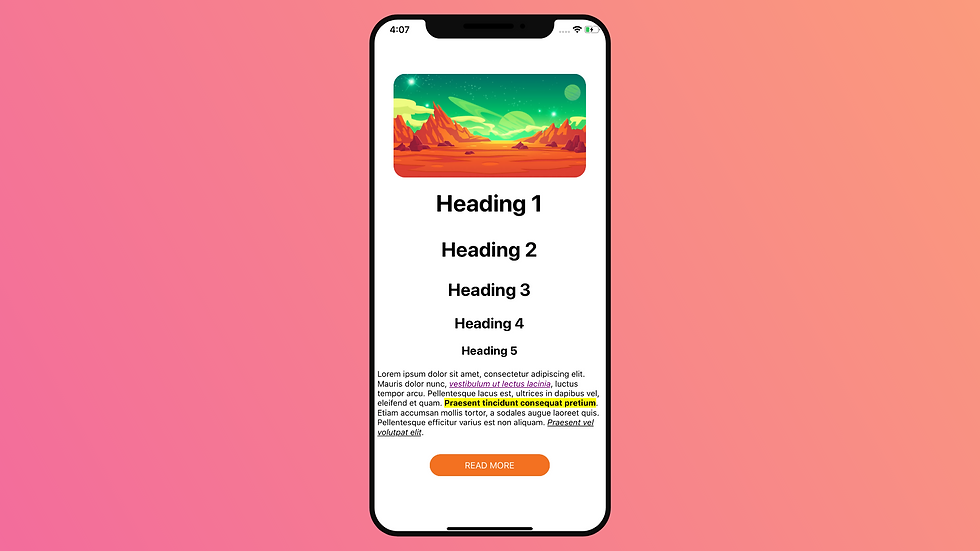Optimising React Native Apps: Crafting Efficient and Smooth User Interfaces
- Instaily

- Nov 13, 2023
- 3 min read
Updated: Nov 14, 2023

In the dynamic world of React Native app development, crafting an exceptional user experience is not merely an option; it's an imperative. With user expectations skyrocketing and patience dwindling, ensuring a seamless and responsive user interface is paramount. This blog delves into the intricacies of optimizing React Native apps, empowering you to transform your creations into masterpieces of efficiency and smoothness.
Mastering Component Lifecycle
Understanding the React component lifecycle is fundamental to optimizing a React Native app. Components go through phases from initialization to rendering and updating. By leveraging lifecycle methods such as shouldComponentUpdate and componentDidUpdate, you can fine-tune when components re-render, preventing unnecessary updates and enhancing overall performance.
Virtualized Lists for Large Data Sets
When dealing with extensive data sets, virtualized lists become a game-changer. React Native provides components like FlatList and SectionList that efficiently render only the items currently in view. This significantly reduces the rendering load, leading to faster startup times and smoother scrolling experiences. Join our React Native App Development course for better understanding.
Image Optimization
Images often contribute to slow load times. To address this, use optimized image formats like WebP when possible. Additionally, employ tools like react-native-fast-image to enhance image loading performance. Lazy loading images and implementing caching strategies can further minimize the impact on your app's responsiveness.
Code Splitting
Breaking down your code into smaller, manageable chunks through code splitting can drastically improve app performance. Consider dynamically loading modules based on user interactions or specific routes. Tools like React Navigation allow for dynamic imports, enabling a more efficient use of resources.
Memory Management
Memory leaks can significantly impact the performance of your React Native app. Utilize tools like the Chrome DevTools or React DevTools to identify and fix memory issues. Properly managing references and cleaning up resources in componentWillUnmount can prevent memory leaks and contribute to a more stable application.
Optimizing Network Requests
Efficiently handling network requests is essential for a smooth user experience. Utilize asynchronous tasks and implement mechanisms like request debouncing to prevent a flood of requests. Caching strategies, such as utilizing the AsyncStorage for local caching, can further reduce load times and improve overall responsiveness.
UI Thread and Native Modules
Understanding the threading model in React Native is crucial. Heavy computations or time-consuming tasks should be offloaded to a separate thread to prevent blocking the UI thread. Native modules can also be employed to handle performance-intensive tasks natively, enhancing the overall efficiency of your app.
Use of PureComponent and React.memo
Optimize functional components by using React.memo or class components with PureComponent. These optimizations reduce unnecessary re-renders by performing shallow comparisons of props and state. This is particularly effective for complex UI components or lists.
Performance Monitoring
Regularly monitor your app's performance using tools like Flipper, React DevTools, or third-party services like New Relic or Sentry. Performance monitoring helps identify bottlenecks and provides insights into areas that need optimization, ensuring your app remains efficient as it evolves.
Implementing a Smart Loading Strategy
Loading all assets and data at once during the app's startup can lead to increased initial load times. Implement a smart loading strategy by prioritizing essential assets and deferring non-essential ones. This approach ensures that users get to interact with the core features of your app more quickly.
Conclusion,
Optimizing React Native apps for efficient and smooth user interfaces involves a combination of understanding the framework's internals, employing best practices, and leveraging tools to monitor and fine-tune performance. By mastering the component lifecycle, utilizing virtualized lists, optimizing images, and addressing memory management, you can create a responsive and delightful user experience.
Remember, app optimization is an ongoing process. Regularly assess your app's performance, stay informed about the latest React Native updates, and be proactive in adopting new techniques and best practices. Through a thoughtful approach to optimization, you can ensure that your React Native app not only meets but exceeds user expectations for speed and responsiveness.


Comments